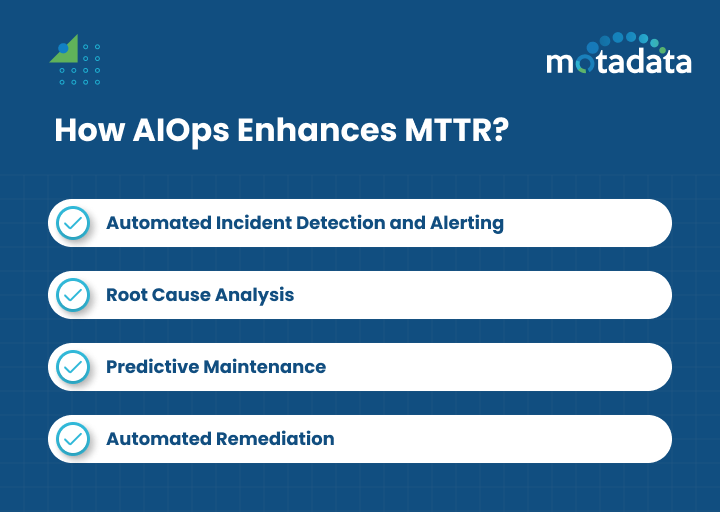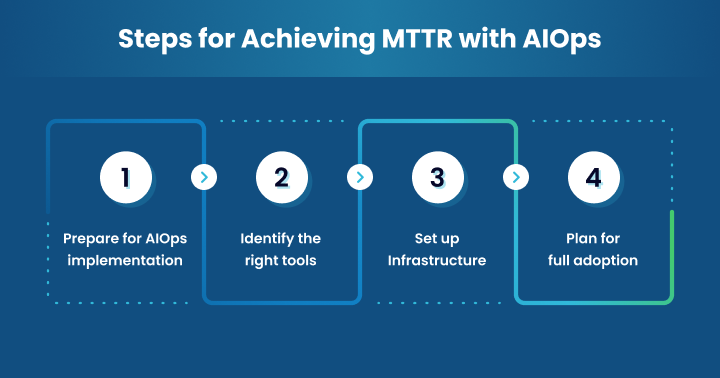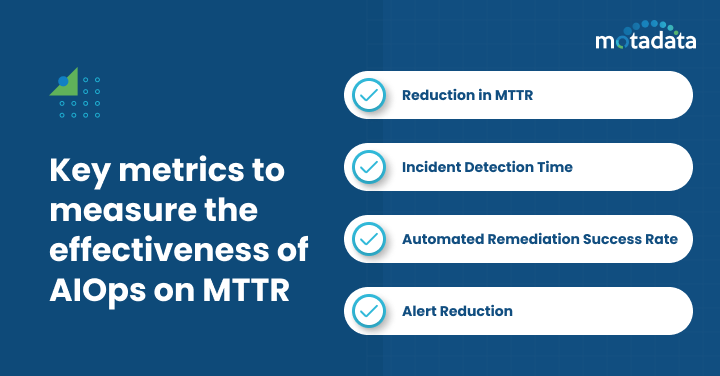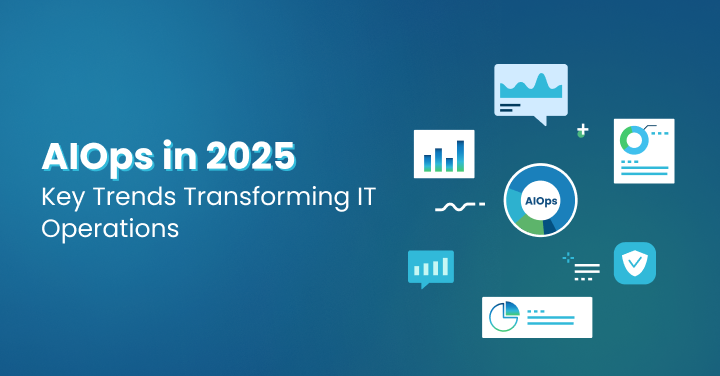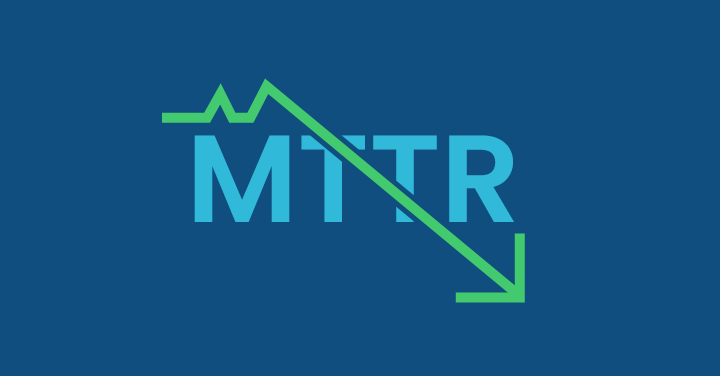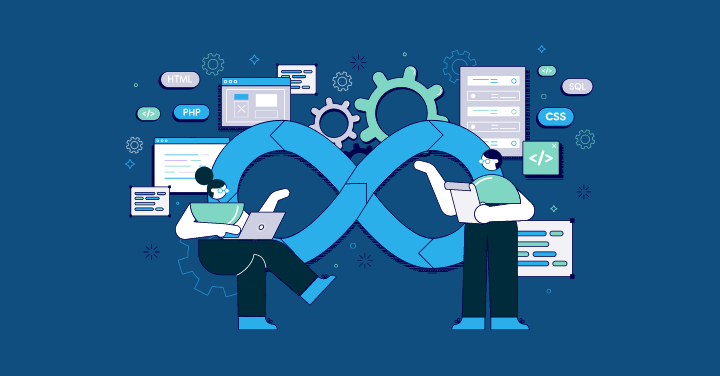In today’s fast-paced digital world, customer satisfaction is the top priority of every other business.
To ensure that customer stays satisfied with your service and application at all times, businesses must work on reducing their downtime and guarantee quick resolutions.
Excessive downtime can be expensive for any business and its brand reputation.
Hence, adapting practices that eliminate issues responsible for downtime is crucial for maintaining seamless IT operations. Similarly, businesses must comply with MTTR to track resolution times.
Mean Time to Resolution (MTTR) is a key metric most organizations use to track how quickly and efficiently a system recovers from errors.
It helps measure the average time a business takes to resolve an issue within a system.
A lower MTTR count is great for businesses because system issues can be fixed quickly. It is also vital for customer satisfaction and operational efficiency.
The emergence of Artificial Intelligence for IT Operations has provided enterprises with strong tools to improve their incident response abilities and accelerate time to recovery (MTTR).
Let us dig deeper into the topic in this blog and understand how AIOps can help enhance MTTR and its challenges.
Further, we have penned down the future trends and MTTR.
Understanding MTTR
Mean Time to Resolution (MTTR) refers to a metric that helps figure out how long an administrator or help desk staff takes to resolve an issue or incident.
The metrics cover from the period of receiving the issue to resolving it and responding to the user.
In IT operations, it is an important key performance indicator that helps measure the efficiency and effectiveness of an incident management system.
A high MTTR score generally means that the issue resolution time is poor and may lead to prolonged downtimes.
However, a lower MTTR count signifies that the system issues are fixed quickly which may result in better customer satisfaction and brand reputation.
By examining MTTR, businesses can determine where they need to improve their ability to handle disruptions promptly, resulting in reduced downtime and optimal operation.
There are various factors that may influence MTTR with AIOps, for example, incident detection period, identification of the root cause of a problem, and tools and technologies used for analysis and monitoring the problem.
Introduction to AIOps
Artificial Intelligence for IT Operations is used in IT environments to enhance the performance of IT operations.
This practice involves the application of artificial intelligence and machine learning to improve operational tasks by saving time and effort.
Further, it helps manage incidents smartly, perform root cause analysis in real-time, and remediate issues before they create any impact.
It leverages automation to help IT teams manage different challenges easily and guarantee smooth operations.
Machine learning, big data analytics, and automation of routine tasks are some of the key components of AIOps that play an important role in making operational tasks better.
Machine learning uses algorithms to analyze data and detect issues in real time.
Big data analytics, on the other hand, helps process large data volumes from different sources for making informed decisions.
Automation helps perform routine tasks automatically and reduces human error. Further, the practice of automation helps speed up resolution time.
By implementing AIOps in IT operations, businesses can detect anomalies at an initial stage and take corrective measures.
Further, with the help of machine learning algorithms, organizations can identify patterns and find the actual cause of a problem in real time.
Further, alerts are intelligently filtered to cut down on noise and make sure IT staff are concentrating on important problems.
With predictive analytics, possible errors can be foreseen, enabling corrective action to be taken before problems arise.
How AIOps Enhances MTTR?
With the aid of MTTR, service desks may assist DevOps in maintaining the stability and performance of their systems while preventing major outages simultaneously.
It is never simple to calculate mean time to resolution. Sometimes it takes longer to mitigate a simple issue than anticipated, and sometimes it takes less time to mitigate a critical incident.
But by adopting these practices, businesses can improve MTTR score and brand reputation. There are many more benefits to using AIOps that can further help enhance MTTR, such as:
Automated Incident Detection and Alerting
AIOps uses AI algorithms and machine learning practices to monitor the overall system, its performance, and issues in real time.
It collects data from multiple sources, including the log streams and metrics to run analysis and find out the bugs at an initial stage.
By detecting anomalies at an early stage, IT teams can resolve issues promptly and reduce MTTR.
With this strategy, businesses can prevent service interruptions before they happen.
This further helps keep the downtime low and guarantees a better user experience.
Another challenge that IT operation teams often face is a high volume of alerts.
With the help of the AIOps platform, team members can use intelligent filters that help in prioritizing alerts depending majorly on their impact as well as severity level.
With this filter feature, businesses can reduce alert fatigue and enable quick response to incidents.
Root Cause Analysis
Identifying actual problems with the traditional root cause analysis method is quite complex and time-consuming.
However, with advanced technology and machine learning practice, businesses can more visibility into business services and go through their historical data, identify patterns, and pinpoint the real cause of problems faster.
It also speeds up the process and allows businesses to fix issues before they impact or escalate.
Automatic log analysis and interpretation enables IT teams to address anomalous activity quickly and efficiently.
This proactive planning minimizes disruptions, keeps things operating smoothly, and increases customer satisfaction.
For instance, a sudden spike in network latency can occur for various reasons.
By running a quick analysis of the historical data and log files, you can learn more about the service impact and find the fault quite easily, thus reducing MTTR.
Predictive Maintenance
Machine learning algorithms in AIOps play a key role in predicting issues before they take place based on past performance and real-time data monitoring.
By identifying issues, such as outdated security features or maintenance issues before they occur, businesses can avoid any form of unplanned downtime.
Through time-series analysis, artificial intelligence (AI) can predict when a system is likely to malfunction.
In 2021, IBM, Lenovo, and other high-profile brands experienced unplanned downtime due to server reliability issues.
Most of them implemented an AIOps platform for predictive maintenance to tackle the issue.
The IT staff was able to carry out maintenance during off-peak hours, preventing significant disruptions and lowering MTTR, thanks to the platform’s prediction of server failures and data breaches based on usage patterns, security data settings, and past events.
Another case study of predictive analytics is of a multinational financial institution that an AI chatbot to enhance their ATM cash management practices.
The chatbot forecasted the ideal cash amounts for every ATM by examining historical data.
Automated Remediation
The speed at which IT issues are resolved is greatly accelerated by the use of AI and self-healing capabilities to solve problems automatically.
When intelligent automation from AIOPS is used, issues can be resolved quickly, improving service performance and reducing downtime.
Let’s say, in order to fix a server with excessive CPU use, the platform might automatically assign more resources or restart the server.
This way the resolution times will get accelerated, eventually lessening the need for personal intervention.
You can even integrate existing IT Service Management (ITSM) systems with AIOps platforms to increase their functionality.
AIOps guarantees that issues are handled quickly by automating the processes involved in incident creation, assignment, and resolution, lowering MTTR.
The unified picture of issues and resolutions that integration with ITSM tools provides makes better tracking and reporting possible.
Implementing AIOps for Improved MTTR
Turning to AIOps to improve efficiency and performance has become a necessity for increasingly complex IT operations.
So, it is best to implement AIOps to improve your MTTR. Here’s how.
Steps for Achieving MTTR with AIOps
1. Prepare for AIOps implementation:
Before implementation, be clear on your objectives and data resources essential for AIOps.
Assess your existing IT infrastructure and identify how implementing AIOps will benefit your applications and services.
Discuss the planning and implementation process with your team members and stakeholders.
2. Identify the right tools:
There are multiple AIOps tools available in the market, but make sure to invest in the right one based on its ability to integrate well with existing IT infrastructure and ease of use.
Compare different options and then make the right choice for your business.
3. Set up Infrastructure:
AIOps requires an effective platform that can manage massive amounts of data in real time.
Companies can set up the required AIOps infrastructure by using cloud-based platforms like Microsoft Azure and Amazon Web Services (AWS) to manage, process, and analyze data.
4. Plan for full adoption:
This entails imagining the revolutionary effect that AIOps can have on your company and establishing precise objectives and benchmarks to reach complete implementation.
AIOps Best Practices to Enhance Visibility
Make sure to apply the following best practices for deploying AIOps solutions:
1. Build a Strong Foundation:
To guarantee the success of AIOps implementation, a strong foundation is necessary, i.e., a well-defined data collection and analysis process, the right AIOps technologies, and clear business goals and objectives.
2. Appropriate mechanism for data collection and processing:
Since it significantly depends on data, it’s imperative to set up adequate systems for data processing and collecting.
Determining the pertinent data points, identifying the data sources, and having the appropriate technology to handle the data are all part of this.
3. Data Security:
Data security is another essential practice crucial for safe implementation.
Tag and secure your data, review and update the configurations, look for loopholes, and adapt to changing environments.
4. Create a culture of collaboration:
For AIOps to be implemented successfully, IT operations teams (ITops Teams) and other departments must collaborate.
This entails open communication, data exchange, and shared objectives.
Key metrics to measure the effectiveness of AIOps on MTTR
- Reduction in MTTR: track the reduction in average resolution time.
- Incident Detection Time: Keep track of how long it takes to find incidents both before and after AIOps is implemented.
- Automated Remediation Success Rate: Analyze the effectiveness of the automated remediation actions and operations.
- Alert Reduction: track the reduction in the number of alerts and false positives.
Challenges and Considerations
Some of the major challenges in AIOps practices include:
1. Data Quality and Integration Issues:
Due to the large amount of data generated constantly, it can be challenging to ensure high-quality data and seamless integrations with existing systems.
However, organizations can overcome the challenge by implementing robust data governance practices.
These practices include data validation, cleansing, and normalization, which offer more accuracy and reliability.
2. AI model Complexity :
Another major challenge is expertise in developing and maintaining these complex AI models. Many businesses may be unaware of how AI and AIOps might enhance IT operations.
IT teams can raise awareness among stakeholders about the features and uses of AIOps to overcome this challenge by running training programs.
Sharing use cases and success stories of how AIOps can also assist organizations in achieving their IT operations objectives.
3. Cultural Resistance :
There are various work organizations where employees resist change or adapt AI-driven solutions.
It can be challenging for professionals to convince them with words and maintain a good work culture.
Hence, it is recommended that they be trained or shown how this practice can ease their work and benefit them in the long run in the complex IT environment.
You can even run workshops to demonstrate the benefits of adopting this practice.
Future Trends in AIOps and MTTR
AIOps is constantly evolving with the emergence of new technologies, such as edge computing or advanced analytics.
AI and machine learning technologies will majorly impact IT operations as they develop.
Upcoming AIOps platforms will have improved self-learning and adaptability capabilities and will be more independent.
By learning from fresh data and experiences, these platforms will be able to continuously enhance their functionality, resulting in even quicker and more precise issue detection, root cause investigation, and treatment.
Additionally, AI chatbot integrations, virtual assistance, and many more options in the market can be a great source to improve communication and collaboration within IT teams, which will help reduce MTTR.
These new technologies will provide real-time support, guidance, and quick solutions for troubleshooting complex user issues.
It is anticipated that MTTR would drastically decline in several businesses in the AIOps age.
Predictive maintenance, automated incident detection, and intelligent root cause analysis together can help firms tackle problems more quickly than in the past.
The average MTTR will keep falling as AIOps platforms advance in sophistication and ubiquity, increasing operational effectiveness and decreasing downtime.
AIOps capabilities will also continue to be improved due to the ongoing development of AI algorithms and the growing availability of high-quality data.
Businesses that take advantage of these developments will be better positioned to operate at peak efficiency and keep a competitive advantage in their respective markets.
FAQs:
Thanks to its outstanding capabilities, you can solve issues much more quickly with AIOps. To begin with, it can recognize when something is wrong automatically and apply root cause analysis to determine why it occurred.
Operations are made more seamless by anticipating problems in the future before they arise and resolving them on their own.
Because automated remediation allows for faster repairs than ever, there will be less downtime.
Together, these components ensure that accidents are handled more quickly while preventing recurrence of the same issues.
without requiring a manual effort. This improved procedure reduces the need for humans to intervene and manually resolve issues, hence increasing the mean time to resolution.
It is extremely beneficial for all types of enterprises since it reduces the time it takes to resolve problems by automating incident solving, identifying the root cause of problems, and forecasting future issues.
It’s adaptability puts it at the forefront of improving IT operations and guarantees a more seamless client experience across all industries.


